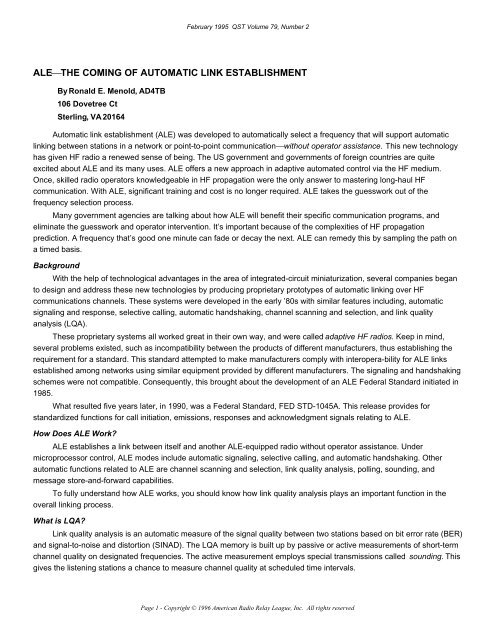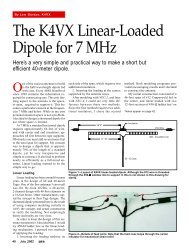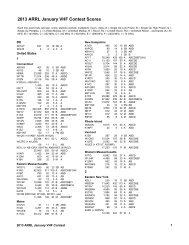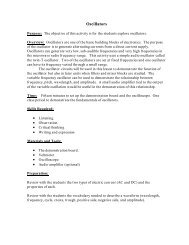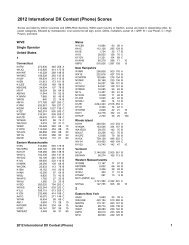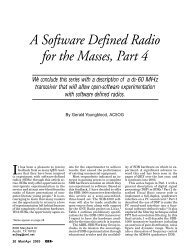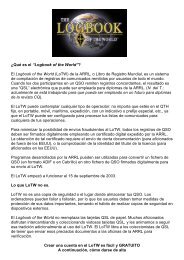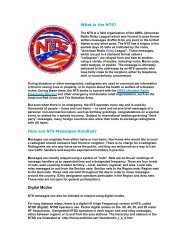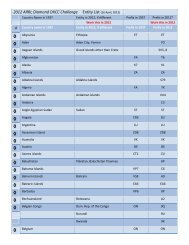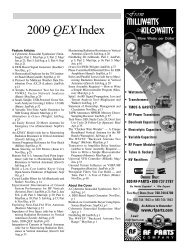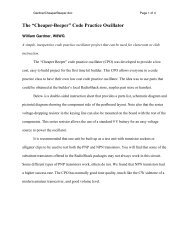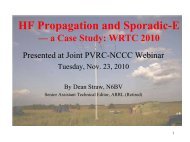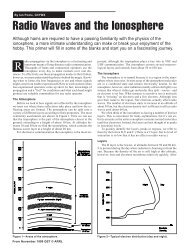ALE.THE COMING OF AUTOMATIC LINK ESTABLISHMENT - ARRL
ALE.THE COMING OF AUTOMATIC LINK ESTABLISHMENT - ARRL
ALE.THE COMING OF AUTOMATIC LINK ESTABLISHMENT - ARRL
Create successful ePaper yourself
Turn your PDF publications into a flip-book with our unique Google optimized e-Paper software.
<strong>ALE</strong>⎯<strong>THE</strong> <strong>COMING</strong> <strong>OF</strong> <strong>AUTOMATIC</strong> <strong>LINK</strong> <strong>ESTABLISHMENT</strong><br />
By Ronald E. Menold, AD4TB<br />
106 Dovetree Ct<br />
Sterling, VA 20164<br />
February 1995 QST Volume 79, Number 2<br />
Automatic link establishment (<strong>ALE</strong>) was developed to automatically select a frequency that will support automatic<br />
linking between stations in a network or point-to-point communication⎯without operator assistance. This new technology<br />
has given HF radio a renewed sense of being. The US government and governments of foreign countries are quite<br />
excited about <strong>ALE</strong> and its many uses. <strong>ALE</strong> offers a new approach in adaptive automated control via the HF medium.<br />
Once, skilled radio operators knowledgeable in HF propagation were the only answer to mastering long-haul HF<br />
communication. With <strong>ALE</strong>, significant training and cost is no longer required. <strong>ALE</strong> takes the guesswork out of the<br />
frequency selection process.<br />
Many government agencies are talking about how <strong>ALE</strong> will benefit their specific communication programs, and<br />
eliminate the guesswork and operator intervention. It’s important because of the complexities of HF propagation<br />
prediction. A frequency that’s good one minute can fade or decay the next. <strong>ALE</strong> can remedy this by sampling the path on<br />
a timed basis.<br />
Background<br />
With the help of technological advantages in the area of integrated-circuit miniaturization, several companies began<br />
to design and address these new technologies by producing proprietary prototypes of automatic linking over HF<br />
communications channels. These systems were developed in the early ’80s with similar features including, automatic<br />
signaling and response, selective calling, automatic handshaking, channel scanning and selection, and link quality<br />
analysis (LQA).<br />
These proprietary systems all worked great in their own way, and were called adaptive HF radios. Keep in mind,<br />
several problems existed, such as incompatibility between the products of different manufacturers, thus establishing the<br />
requirement for a standard. This standard attempted to make manufacturers comply with interopera-bility for <strong>ALE</strong> links<br />
established among networks using similar equipment provided by different manufacturers. The signaling and handshaking<br />
schemes were not compatible. Consequently, this brought about the development of an <strong>ALE</strong> Federal Standard initiated in<br />
1985.<br />
What resulted five years later, in 1990, was a Federal Standard, FED STD-1045A. This release provides for<br />
standardized functions for call initiation, emissions, responses and acknowledgment signals relating to <strong>ALE</strong>.<br />
How Does <strong>ALE</strong> Work?<br />
<strong>ALE</strong> establishes a link between itself and another <strong>ALE</strong>-equipped radio without operator assistance. Under<br />
microprocessor control, <strong>ALE</strong> modes include automatic signaling, selective calling, and automatic handshaking. Other<br />
automatic functions related to <strong>ALE</strong> are channel scanning and selection, link quality analysis, polling, sounding, and<br />
message store-and-forward capabilities.<br />
To fully understand how <strong>ALE</strong> works, you should know how link quality analysis plays an important function in the<br />
overall linking process.<br />
What is LQA?<br />
Link quality analysis is an automatic measure of the signal quality between two stations based on bit error rate (BER)<br />
and signal-to-noise and distortion (SINAD). The LQA memory is built up by passive or active measurements of short-term<br />
channel quality on designated frequencies. The active measurement employs special transmissions called sounding. This<br />
gives the listening stations a chance to measure channel quality at scheduled time intervals.<br />
Page 1 - Copyright © 1996 American Radio Relay League, Inc. All rights reserved
February 1995 QST Volume 79, Number 2<br />
Passive measurements are those made only when links are established, or when other stations are heard by chance<br />
as they are calling third-party stations. In both types of channel measurements, all stations in a network agree in advance<br />
on the set of frequencies in the particular scan group they will use for <strong>ALE</strong> attempts. All stations not linked to others<br />
automatically revert to their scan mode and listen for scheduled or random <strong>ALE</strong> calls. LQA memory complements the <strong>ALE</strong><br />
linking process. Let’s examine how the complete <strong>ALE</strong> protocol works to establish a communication link.<br />
The Full <strong>ALE</strong> Operation<br />
First, the transceiver is set to the <strong>ALE</strong> scanning mode. Most units can scan up to 100 channels at two to five<br />
channels per second. While scanning, the receiver continuously monitors the activity for incoming <strong>ALE</strong> signals. When<br />
heard, these signals are evaluated for channel link quality, and the data is stored in memory for future reference.<br />
Secondly, when a station wants to contact another station, the initiating radio checks its LQA memory for the latest,<br />
or best channel to use for that particular station. It verifies that the channel is not busy, and then transmits a digital call<br />
signal on that channel. This call signal follows a specific protocol and includes the selective call addresses of both the<br />
called and the calling stations. If the called station receives and decodes the call properly, it will respond with a specific<br />
signal acknowledgment.<br />
On receiving the response, the calling station sends out a confirmation signal and a link is established. If no link is<br />
established on the first channel the initiating radio tried, the system then tries the other channels in that scan group ⎯in<br />
order of remembered quality⎯until a link is established on one of the preprogrammed channels.<br />
The <strong>ALE</strong> transmission tones sound unique and strange when you first hear them. The continuous warbling-tone<br />
calling sequence lasts about 20 to 90 seconds during the initial linking progress.<br />
Automatic Message Display<br />
Automatic message display (AMD) is a digital order-wire. An initiating station links with a distant station and sends a<br />
digital AMD message up to 90 characters long. If unattended, the distant terminal stores the message(s) for later reading.<br />
This AMD function is part of the framing signal and has an internal data rate of about 100 wpm.<br />
<strong>ALE</strong> Test Results<br />
<strong>ALE</strong> testing was conducted in two phases: bench hook-up and on-the-air tests. Both were successfully<br />
accomplished. Conclusive tests were conducted by several companies including Frederick, Harris, Sunair,<br />
Rockwell-Collins, and Transworld, all manufacturers of <strong>ALE</strong> controllers and peripheral HF equipment, including<br />
transceivers with embedded <strong>ALE</strong> capability. Equipment options include digital signal processing (DSP), high-speed<br />
modems and others too numerous to mention. Several government agencies were involved in testing the first HF <strong>ALE</strong><br />
controllers during the latter part of 1990.<br />
<strong>ALE</strong> can complement other digital formats and high-speed synchronous modems. Most units support 2400-bit/s<br />
39-tone modems and others using unique protocols. In addition, some manufacturers offer optional DSP to enhance SSB<br />
voice or digital signals, reducing atmospheric interference and channel dynamics, to give processed-signal quality. There<br />
are many software packages and hardware interfaces produced by third-party vendors that work with many <strong>ALE</strong> units.<br />
Your Tax Dollars at Work<br />
<strong>ALE</strong> is causing quite a commotion. Not only are government agencies excited, but private industry has jumped on<br />
the bandwagon in support of government contracts. Just when many government agencies were scaling down their HF<br />
operations⎯with satellite and higher data rates taking preference⎯<strong>ALE</strong> arrived.<br />
Amateur Benefits<br />
Why isn’t the gear on your amateur equipment dealer’s shelf so you can purchase it and really start having fun? You<br />
can benefit from this new technology if you show the manufacturers the need is there for them to pursue development of<br />
a low-cost version that employs some of the same linking protocol as that of the high-end government models. If amateur<br />
response is high, the potential exists to encourage manufacturers to survey US and foreign amateur markets for potential<br />
Page 2 - Copyright © 1996 American Radio Relay League, Inc. All rights reserved
February 1995 QST Volume 79, Number 2<br />
sales.<br />
High-frequency <strong>ALE</strong> is a relatively new term in the amateur community where amateurs are learning of new digital<br />
modes such as PacTOR, Clover⎯and the latest arrival, G-TOR. Now, here comes this automatic linking protocol that<br />
takes all the guesswork out of propagation prediction. I don’t know about you, but I have a lot of ideas for this thing called<br />
<strong>ALE</strong>!<br />
Amateur Use<br />
If you’re like me, I have only a few minutes to conduct a scheduled contact. If that fails, I must try again later. Many<br />
of you have been in that situation, I’m sure. Remember the schedule you had with your relative or friend and missed it?<br />
Remember calling for five minutes (it seemed like five hours)? Remember blaming poor band conditions that interrupted<br />
your contact? Remember waiting until the next week⎯or month⎯to have another try? If you had an <strong>ALE</strong> controller, you<br />
could easily link with relatives and friends around the world. <strong>ALE</strong> can, in most cases, overcome propagation changes ⎯<br />
provided you have prepro-grammed channels in several bands to increase your chances of linking.<br />
If the FCC rules permitted, with <strong>ALE</strong>, you could instantly link with anyone⎯day or night⎯and leave an AMD<br />
message on a scheduled basis without the recipients being around. Remote control and other interfaces are just a few of<br />
the exciting things that are now being produced.<br />
Undoubtedly, many amateurs have heard the <strong>ALE</strong> linking sound on government HF frequencies above and below<br />
the amateur bands but have failed to recognize it. <strong>ALE</strong> has arrived⎯and is here to stay. You have an opportunity to get<br />
involved in the future of <strong>ALE</strong>. It’s yours for the asking!<br />
<strong>ALE</strong> Disadvantages<br />
There are a couple of detractors related to <strong>ALE</strong> that exist for amateurs. These are frequency selection and<br />
interference problems. Unlike the government, which has a greater selection of frequencies, amateurs are confined to<br />
specific bands. <strong>ALE</strong> requires a wide range of frequencies to select the best channel. In addition, the initial linking call<br />
could interfere with other digital signals on that same frequency. You must listen before transmitting or attempting to link. I<br />
can see how regulation and much discussion needs to take place before <strong>ALE</strong> will become practical for amateur use. It can<br />
be a reality⎯if the minds of many solve the problems that face our unique situation.<br />
Summary<br />
<strong>ALE</strong> is the perfect answer for the replacement of obsolete HF government stations. With government and military<br />
downsizing, this technology is a welcome replacement with FED STD 1045A in place. This new linking protocol can meet<br />
the communication requirements of the future. It’s the perfect HF backup for voice and data when the primary means of<br />
communication fail. <strong>ALE</strong> offers a better mousetrap for your tax dollar and gives HF a renewed place in digital and voice<br />
communication throughout government and industry.<br />
Further Reading<br />
“The Growing Family of Federal Standards for HF Radio Automatic Link Establishment (<strong>ALE</strong>),” by Paul C. Smith,<br />
K3ZMO, and Dennis Bodson, W4PWF, July-December 1993 QEX (six-part series).<br />
“<strong>ALE</strong>: A Cure for What Ails HF Communications,” Packet Perspective, November 1993 QST, p 107.<br />
“A Family of Federal Standards for HF <strong>ALE</strong> Radios,” by Robert Adair, KA0CKS, and Dennis Bodson, W4PWF,<br />
November 1992 QST, p 73.<br />
Page 3 - Copyright © 1996 American Radio Relay League, Inc. All rights reserved


